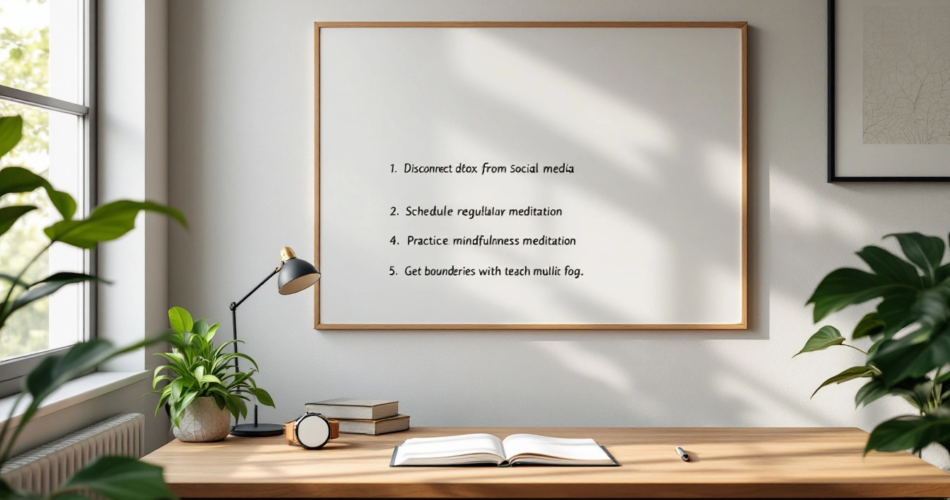Did you know that the average office worker checks their email 50 times a day and engages with their smartphone more than 2,600 times? Our hyper-connected lifestyles aren’t just stressful but are also wreaking havoc on productivity. Constant notifications, endless scrolling, and the pressure to stay “always online” contribute to brain fog, reduced focus, and diminished efficiency. It’s no wonder you might feel drained and unproductive at the end of the day.
The good news? A digital detox for productivity improvement might just be the antidote to these modern-day challenges. In this article, you’ll discover seven practical ways to clear your mind, beat brain fog, and reclaim your productivity. Let’s dive in!
Table of Contents
- What is a Digital Detox for Productivity Improvement?
- The Impact of Digital Overload on Productivity
- 7 Powerful Ways to Beat Brain Fog with a Digital Detox
- FAQs
- Conclusion
What is a Digital Detox for Productivity Improvement?
A digital detox involves stepping away from technology, such as your phone, computer, and social media, to focus on creating healthier boundaries with screens. In today’s digital-first world, this practice is pivotal in replenishing mental energy, improving focus, and reclaiming productivity.
When you consciously reduce screen time, you minimize distractions, allowing your brain to reset. This clarity helps you stay on task, make better decisions, and build better work habits.
The Impact of Digital Overload on Productivity
Our brains aren’t equipped to deal with the constant influx of information from emails, messages, and notifications. Research has shown that digital overload can lead to cognitive fatigue, memory issues, and difficulty completing tasks—all symptoms of brain fog.
Signs of digital overload include procrastination, irritability, decreased focus, and feeling overwhelmed. These red flags signal it’s time for a digital detox so you can restore balance and refuel your mental energy.
7 Powerful Ways to Beat Brain Fog with a Digital Detox
1. Unplug During the First and Last Hour of the Day
Start your day screen-free to set the tone for productivity. Instead of diving into emails or social media, replace these habits with a morning routine focused on physical activity, journaling, or reading. This boosts mental clarity and primes your mind for the day ahead.
Similarly, avoid screens before bedtime. Blue light disrupts sleep cycles and makes it harder to unwind. Opt for offline alternatives like reading a physical book or practicing relaxation techniques. These simple changes can significantly improve focus and lower stress levels.
2. Schedule Technology-Free Breaks
Did you know that taking short breaks throughout the day can improve focus and overall productivity? Use these moments to step away from screens entirely. Go for a walk, stretch, or take a power nap to refresh your mind.
Pro tip: Use the Pomodoro technique to work in focused intervals, followed by short, screen-free breaks. This simple routine can do wonders for your productivity.
3. Use Tools to Limit Screen Time
There’s a growing number of tools and apps designed to help you manage your screen time. Programs like Freedom, Moment, and RescueTime allow you to track app usage, set daily limits, and block distracting sites.
By setting boundaries with technology, you’re more likely to focus on what matters most and reduce unnecessary distractions.
4. Set Boundaries for Notifications and Emails
Personalize your phone and computer settings to minimize interruptions. Using “Do Not Disturb” and muting non-essential notifications create a more focused work environment.
Additionally, designate specific times to check emails instead of responding to them immediately. This will eliminate the need to constantly multitask, helping you stay more productive.
5. Replace Digital Activities with Offline Hobbies
Find offline activities that spark joy and recharge your mental batteries. Whether it’s gardening, painting, hiking, or playing a musical instrument, these hobbies can replace time spent mindlessly scrolling online.
By immersing yourself in creative or physical activities, you’ll improve mental clarity and release stress, which in turn amplifies productivity.
6. Leverage Mindfulness and Meditation Practices
Mindfulness can reduce the impulsive urge to constantly check our devices. Practices like meditation, deep breathing, and yoga encourage greater awareness and presence, helping you control the desire to be “always online.”
Start small—just 5-10 minutes a day of mindfulness practice can reset your mind and develop healthier tech habits.
7. Optimize Your Workspace for Focus
A cluttered workspace can contribute to distractions and overwhelm. Declutter your area and remove unnecessary tech items that don’t serve your productivity goals.
Consider ergonomic tools like a comfy chair or a standing desk, as well as analog tools like notebooks to stay organized without devices demanding your attention.
Frequently Asked Questions
1. What are the earliest signs that I need a digital detox for productivity improvement?
Feeling fatigued, distracted, or overwhelmed by notifications are common signs you could benefit from a digital detox.
2. How long should a digital detox last to see noticeable results?
Even short detoxes, like unplugging for 1-2 hours daily, can improve focus. For larger results, try a full weekend or a week-long detox.
3. Are there any tools that assist in planning a successful digital detox?
Yes! Tools like Freedom or Stay Focused can help block distracting apps, while screen-free planners can guide your detox journey.
4. Will this approach work if my job revolves around technology?
Absolutely. Focus on minimizing personal digital distractions and enforcing screen-free times outside work hours.
5. Can a digital detox improve mental health too?
Yes, taking regular breaks from technology can improve mental health, reduce stress, and boost emotional well-being.
Conclusion
In today’s digital world, the key to improving productivity often lies in unplugging. Through a digital detox for productivity improvement, you can beat brain fog, regain clarity, and maximize efficiency. By incorporating these seven simple strategies—like unplugging during key times, setting boundaries, and embracing mindfulness—you’ll create a healthier and more productive relationship with technology.
Take the first step toward your digital detox today and discover the incredible productivity and mental clarity that follows. Your brain (and your to-do list) will thank you!


